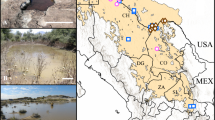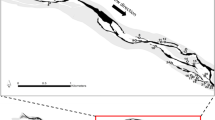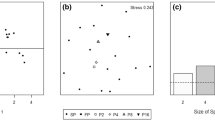Abstract
The development of a community through time, or succession, is generally described as the orderly replacement of species until a deterministic, stable endpoint is reached. However, stochastic factors, coupled with intrinsic biotic factors, such as herbivory or predation, can cause communities within the same habitat to become highly dissimilar in composition. Much research on the succession of terrestrial systems has been conducted, but factors influencing the succession of a terrestrial system may not apply to aquatic systems. To determine whether succession in an aquatic system is deterministic or dominated by contingency of stochastic factors, and the role that higher trophic level interactions and resources have in shaping successional patterns, I followed community development and dynamics of the intermediate and bottom trophic level (protozoans and bacteria) in the model Sarracenia purpurea pitcher plant system throughout an entire growing season. By comparing these dynamics across pitcher plant leaves within the same bog, I was able to determine whether there is a predictable pattern for community assembly in this aquatic community. The results from this study suggest that rather than a sequential replacement of early colonizers with more competitive species through time, competitively superior species establish in newly formed communities simultaneously with less competitive species, which coexist throughout the growing season. Community assembly in this system can also be altered by stochastic events. Resources and predators had a variable effect on the patterns of community change observed during succession. Patterns of community assembly were also dependent on the trophic level examined but, for the bottom trophic level, not on the sampling method used.





Similar content being viewed by others
References
Berlow EL (1997) From canalization to contingency: historical effects in a successional rocky intertidal community. Ecol Monogr 67:435–460
Bray JR, Curtis JT (1957) An ordination of the upland forest communities of southern Wisconsin. Ecol Monogr 27:325–349
Buckley HL, Miller TE, Ellison AM, Gotelli NJ (2003) Reverse latitudinal trends in species richness of pitcher-plant food webs. Ecol Lett 6:825–829
Buckley HL, Miller TE, Ellison AM, Gotelli NJ (2010) Local- to continental-scale variation in the richness and composition of an aquatic food web. Global Ecol Biogeogr 19:711–723
Chase JM, Biro EG, Ryberg WA, Smith KG (2009) Predators temper the relative importance of stochastic processes in the assembly of prey metacommunities. Ecol Lett 12:1210–1218
Clarke KR, Gorley RN (2006) PRIMER v6: user manual/tutorial. Plymouth, PRIMER-E
Clements FE (1916) Plant succession: an analysis of the development of vegetation. Carnegie Institution of Washington, Washington, p 512
Clements FE (1936) Nature and structure of the climax. J Ecol 24:252–284
Connell JH, Slatyer RO (1977) Mechanisms of succession in natural communities and their role in community stability and organizations. Am Nat 11:1119–1144
DeSantis TZ, Hugenholtz P, Keller K, Brodie EL, Larsen N, Piceno YM, Phan R, Andersen GL (2006) NAST: a multiple sequence alignment server for comparative analysis of 16S rRNA genes. Nucleic Acids Res 34:W394–W399
Fish D, Hall DW (1978) Succession and stratification of aquatic insects inhabiting the leaves of the insectivorous pitcher plant, Sarracenia purpurea. Am Midl Nat 99:172–183
Gleason HA (1917) The structure and development of the plant association. Bull Torrey Bot Club 43:463–481
Gleason HA (1927) Further views on the succession-concept. Ecology 8:299–326
Gotelli NJ, Ellison AM (2006) Food-web models predict species abundance in response to habitat change. PLoS Biol 44:e324
Gray SM (2011) Community assembly dynamics and consequences of invasion: tests with the Sarracenia purpurea model system. PhD diss. Stony Brook University, Stony Brook, NY
Gray SM, Miller TE, Mouquet N, Daufresne T (2006) Nutrient limitation in Sarracenia purpurea microcosms. Hydrobiologia 573:173–181
Heard SB (1994) Pitcher-plant midges and mosquitoes: a processing chain commensalism. Ecology 75:1647–1660
Hutchinson GE (1961) The paradox of the plankton. Am Nat 95:137–145
Johnson JL (1994) Similarity analysis of rRNAs. In: Gerhardt PE, Wood WA, Krieg NR (eds) Methods for general and molecular bacteriology. Am Soc Microbiol, Washington, DC, pp 683–700
Kneitel JM (2002) Species diversity and trade-offs in pitcher plant (Sarracenia purpurea) inquiline communities. PhD diss. Florida State University, Tallahassee, FL
Kneitel JM, Miller TE (2002) The effects of resource and top-predator addition to the inquiline community of the pitcher plant Sarracenia purpurea. Ecology 83:680–688
Koopman M, Carstens BC (2011) The microbial phyllogeography of the carnivorous plant Sarracenia alata. Microb Ecol 6:750–758
Koopman M, Fuselier D, Hird S, Carstens BC (2010) The carnivorous pale pitcher plant harbors diverse, distinct and temporally dependent bacterial communities. Appl Environ Microbiol 76:1851–1860
Miller TE, terHorst CP (2012) Testing successional hypotheses of stability, heterogeneity, and diversity in pitcher-plant inquilines communities. Oecologia 170:243–251
Odum EP (1969) The strategy of ecosystem development. Science 164:262–270
Paine RT (1966) Food web complexity and species diversity. Am Nat 100:65–75
Peterson CN, Day S, Wolfe BE, Ellison AM, Kolter R, Pringle A (2008) A keystone predator controls bacterial diversity in the pitcher plant (Sarracenia purpurea) microecosystem. Environ Microbiol 10:2257–2266
Wilson KH, Blitchington RB, Greene RC (1990) Amplification of bacterial 16S ribosomal DNA with polymerase chain reaction. J Clin Microbiol 28:1942–1946
Acknowledgments
I would especially like to thank Dianna Padilla, Dan Dykhuizen, Jessica Gurevitch, Shahid Naeem, Olivier Broennimann and three anonymous reviewers for their edits, useful comments and insight throughout this project. I am grateful to the Stony Brook University undergraduates, Maria Aguilar and Miriam Habiel, for their field assistance and to collaborator Denise Akob for her help with producing clone libraries. This project was funded by the Stony Brook University Slobodkin Award and by grant number NIH GM060731 with Dan Dykhuizen as the PI. This is contribution 1217 from the Department of Ecology and Evolution at Stony Brook University.
Author information
Authors and Affiliations
Corresponding author
Additional information
Handling Editor: Liesbeth Bakker
Electronic supplementary material
Below is the link to the electronic supplementary material.
Rights and permissions
About this article
Cite this article
Gray, S.M. Succession in the aquatic Sarracenia purpurea community: deterministic or driven by contingency?. Aquat Ecol 46, 487–499 (2012). https://doi.org/10.1007/s10452-012-9417-9
Received:
Accepted:
Published:
Issue Date:
DOI: https://doi.org/10.1007/s10452-012-9417-9




